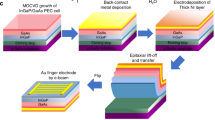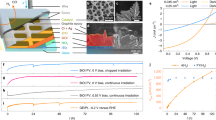Abstract
Harnessing solar energy to drive photoelectrochemical reactions is widely studied for sustainable fuel production and versatile energy storage over different timescales. However, the majority of solar photoelectrochemical cells cannot drive the overall photosynthesis reactions without the assistance of an external power source. A device for simultaneous and direct production of renewable fuels and electrical power from sunlight is now proposed. This hybrid photoelectrochemical and photovoltaic device allows tunable control over the branching ratio between two high-value products of solar energy conversion, requires relatively simple modification to existing photovoltaic technologies, and circumvents the photocurrent mismatches that lead to significant loss in tandem photoelectrochemical systems comprising chemically stable photoelectrodes. Our proof-of-concept device is based on a transition metal oxide photoanode monolithically integrated onto silicon that possesses both front- and backside photovoltaic junctions. This integrated assembly drives spontaneous overall water splitting with no external power source, while also producing electricity near the maximum power point of the backside photovoltaic junction. The concept that photogenerated charge carriers can be controllably directed to produce electricity and chemical fuel provides an opportunity to significantly increase the energy return on energy invested in solar fuels systems and can be adapted to a variety of architectures assembled from different materials.
This is a preview of subscription content, access via your institution
Access options
Access Nature and 54 other Nature Portfolio journals
Get Nature+, our best-value online-access subscription
$29.99 / 30 days
cancel any time
Subscribe to this journal
Receive 12 print issues and online access
$259.00 per year
only $21.58 per issue
Buy this article
- Purchase on Springer Link
- Instant access to full article PDF
Prices may be subject to local taxes which are calculated during checkout




Similar content being viewed by others
Data availability
The data that support the findings within this paper are available from the corresponding author upon request.
References
Bak, T., Nowotny, J., Rekas, M. & Sorrell, C. C. Photo-electrochemical hydrogen generation from water using solar energy. Materials-related aspects. Int. J. Hydrogen Energy 27, 991–1022 (2002).
Walter, M. G. et al. Solar water splitting cells. Chem. Rev. 110, 6446–6473 (2010).
Hu, S., Xiang, C., Haussener, S., Berger, A. D. & Lewis, N. S. An analysis of the optimal band gaps of light absorbers in integrated tandem photoelectrochemical water-splitting systems. Energy Environ. Sci. 6, 2984–2993 (2013).
Liu, C., Tang, J., Chen, H. M., Liu, B. & Yang, P. A fully integrated nanosystem of semiconductor nanowires for direct solar water splitting. Nano Lett. 13, 2989–2992 (2013).
Shaner, M. R. et al. Photoelectrochemistry of core–shell tandem junction n–p+-Si/n-WO3 microwire array photoelectrodes. Energy Environ. Sci. 7, 779–790 (2014).
Chakthranont, P., Hellstern, T. R., McEnaney, J. M. & Jaramillo, T. F. Design and fabrication of a precious metal-free tandem core-shell p +n Si/W-doped BiVO4 photoanode for unassisted water splitting. Adv. Energy Mater. 7, 1701515 (2017).
Jang, J.-W. et al. Enabling unassisted solar water splitting by iron oxide and silicon. Nat. Commun. 6, 7447 (2015).
Abdi, F. F. et al. Efficient solar water splitting by enhanced charge separation in a bismuth vanadate–silicon tandem photoelectrode. Nat. Commun. 4, 2195 (2013).
Sheridan, M. V. et al. All-in-one derivatized tandem p+n-silicon-SnO2/TiO2 water splitting photoelectrochemical cell. Nano Lett. 17, 2440–2446 (2017).
Shaner, M. R., McDowell, M. T., Pien, A., Atwater, H. A. & Lewis, N. S. Si/TiO2 tandem-junction microwire arrays for unassisted solar-driven water splitting. J. Electrochem. Soc. 163, H261–H264 (2016).
Sivula, K., Le Formal, F. & Grätzel, M. Solar water splitting: progress using hematite (α-Fe2O3) photoelectrodes. ChemSusChem 4, 432–449 (2011).
Warren, S. C. et al. Identifying champion nanostructures for solar water-splitting. Nat. Mater. 12, 842–849 (2013).
Tilley, S. D., Cornuz, M., Sivula, K. & Grätzel, M. Light-induced water splitting with hematite: improved nanostructure and iridium oxide catalysis. Angew. Chem. Int. Ed. 49, 6405–6408 (2010).
Dotan, H. et al. Resonant light trapping in ultrathin films for water splitting. Nat. Mater. 12, 158–164 (2013).
Liu, G. et al. Enabling an integrated tantalum nitride photoanode to approach the theoretical photocurrent limit for solar water splitting. Energy Environ. Sci. 9, 1327–1334 (2016).
Takata, T. et al. Visible-light-driven photocatalytic behavior of tantalum-oxynitride and nitride. Res. Chem. Intermed. 33, 13–25 (2007).
Li, Y. et al. Vertically aligned Ta3N5 nanorod arrays for solar-driven photoelectrochemical water splitting. Adv. Mater. 25, 125–131 (2013).
Zhong, M. et al. Highly active GaN-stabilized Ta3 N5 thin-film photoanode for solar water oxidation. Angew. Chem. Int. Ed. 56, 4739–4743 (2017).
Rothschild, A. & Dotan, H. Beating the efficiency of photovoltaics-powered electrolysis with tandem cell photoelectrolysis. ACS Energy Lett. 2, 45–51 (2016).
Pihosh, Y. et al. Photocatalytic generation of hydrogen by core-shell WO3/BiVO4 nanorods with ultimate water splitting efficiency. Sci. Rep. 5, 11141 (2015).
Zhao, J., Wang, A. & Green, Ma 24.5% efficiency silicon PERT cells on tmMCZ substrates and 24.7% efficiency PERL cells on FZ substrates. Prog. Photovoltaics Res. Appl. 7, 471–474 (1999).
Mulligan, W. P. et al. in Proceedings of the 19th EPVSEC 3–6 (2004).
Segev, G. et al. The spatial collection efficiency of charge carriers in photovoltaic and photoelectrochemical cells. Joule 2, 210–224 (2018).
Coridan, R. H. et al. Methods for comparing the performance of energy-conversion systems for use in solar fuels and solar electricity generation. Energy Environ. Sci. 8, 2886–2901 (2015).
Döscher, H., Geisz, J. F., Deutsch, T. G. & Turner, J. A. Sunlight absorption in water—efficiency and design implications for photoelectrochemical devices. Energy Environ. Sci. 7, 2951–2956 (2014).
Bolton, J. R., Strickler, S. J. & Connolly, J. S. Limiting and realizable efficiencies of solar photolysis of water. Nature 316, 495–500 (1985).
Acknowledgements
This material is based on work performed by the Joint Center for Artificial Photosynthesis, a DOE Energy Innovation Hub, supported through the Office of Science of the US Department of Energy under award no. DE-SC0004993. G.S. acknowledges support by the Israeli Ministry of National Infrastructure, Energy and Water Resources under the programme for post-doctoral fellowships.
Author information
Authors and Affiliations
Contributions
G.S. and I.D.S. initiated this research. G.S. and J.W.B. fabricated the devices. G.S. carried out the measurements and simulations. J.B.G. conducted the EROEI analysis and wrote the section about it. G.S. and I.D.S. wrote the rest of the manuscript. All authors commented on the manuscript. I.D.S. directed the research.
Corresponding author
Ethics declarations
Competing interests
The authors declare no competing interests.
Additional information
Publisher’s note: Springer Nature remains neutral with regard to jurisdictional claims in published maps and institutional affiliations.
Supplementary information
Supplementary Information
Supplementary Figures 1–17, Supplementary Tables 1–3, Supplementary References 1–21
Rights and permissions
About this article
Cite this article
Segev, G., Beeman, J.W., Greenblatt, J.B. et al. Hybrid photoelectrochemical and photovoltaic cells for simultaneous production of chemical fuels and electrical power. Nature Mater 17, 1115–1121 (2018). https://doi.org/10.1038/s41563-018-0198-y
Received:
Accepted:
Published:
Issue Date:
DOI: https://doi.org/10.1038/s41563-018-0198-y
This article is cited by
-
Kilowatt-scale solar hydrogen production system using a concentrated integrated photoelectrochemical device
Nature Energy (2023)
-
Flexible self-charging power sources
Nature Reviews Materials (2022)
-
Hole utilization in solar hydrogen production
Nature Reviews Chemistry (2022)
-
Inter-facet junction effects on particulate photoelectrodes
Nature Materials (2022)
-
DFT based modeling of asymmetric non-fullerene acceptors for high-performance organic solar cell
Optical and Quantum Electronics (2022)



